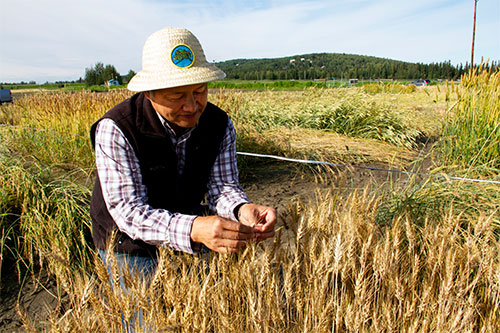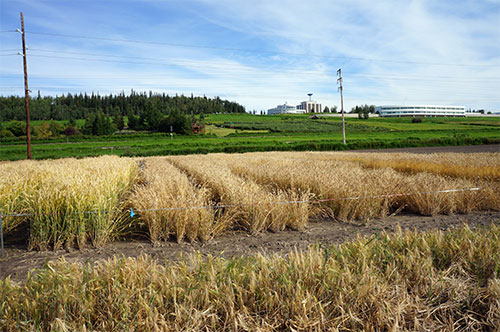
Researchers continue quest for Northern spring wheat varietyBy DEBBIE CARTER
October 26, 2016
University of Alaska Fairbanks agronomist Mingchu Zhang is continuing the research with Bob Van Veldhuizen, a research assistant in agronomy and soils. Zhang believes that with Alaska’s warming climate, more opportunities may exist to find or develop a wheat variety that grows well in Alaska. Russians reportedly tried to grow wheat, with limited success, in coastal Alaska to provide bread flour for the Russian American Co. fur trading posts in the 1790s.
University of Alaska Fairbanks agronomist Mingchu Zhang examines wheat varieties grown in 2016 at the Fairbanks Experiment Farm.
Zhang said that farmers in Alaska, the Yukon and Newfoundland have expressed an interest in an early maturing spring wheat that does not shatter. While hobbyists and Alaska farmers have experimented with growing wheat, no one raises it commercially on a large scale. “If we can grow wheat in the state, it can help with food security,” Zhang said. Since Alaska does not have a plant breeder, he and Van Veldhuizen are working with Washington State University wheat breeder Stephen Jones at the Mount Vernon Research Center. In 2010, Jones’ doctoral student, Karen Hills, developed three crosses with the Ingal variety and other varieties grown in Saskatchewan and Alberta. A second graduate student developed four new varieties of hard red spring wheat in 2014. In summer 2016, Zhang and Van Veldhuizen grew 80 varieties, including the crosses, parent varieties of the crosses and 68 varieties that Jones obtained from northern European countries, including Sweden, Finland, Norway, Denmark and Switzerland. All varieties were grown in a one-acre plot at the Fairbanks Experiment Farm.
A test plot of spring wheat varieties at the Fairbanks Experiment Farm in 2016.
Van Veldhuizen harvested the wheat in late August. While the test weight and yield data are still being analyzed, Zhang said two varieties from Scandinavian countries look promising. They are both “dwarf” varieties, about two feet tall. The process of selection, however, will take years. They expect to grow all varieties again next year, and then will select for the varieties that mature early, don’t shatter, have high yields and don’t fall down. The varieties will also be tested to determine nutrition, baking quality and shelf life. Selections will continue for three to five years in Fairbanks, followed by test plots in Delta Junction and Palmer. “It’s a long process,’’ Van Veldhuizen said. Van Veldhuizen, who has worked with grains research for 36 years, hopes a commercial variety will be found, but, unlike barley, which is resilient in low temperatures, wheat is a much fussier crop, he said. Wheat stops growing when temperatures reach 40 degrees. “Wheat is very, very sensitive to the environment,” he said. Zhang said WSU is interested in their results because it is also trying to develop early maturing wheat to grow in western Washington, particularly for niche markets. While farmers in Alaska want wheat that will mature in a short growing season, Washington farmers want wheat that matures before the late summer rainy season begins.
This article is provided as a public service by the University of Alaska Fairbanks.
Representations of fact and opinions in comments posted are solely those of the individual posters and do not represent the opinions of Sitnews.
|
||

